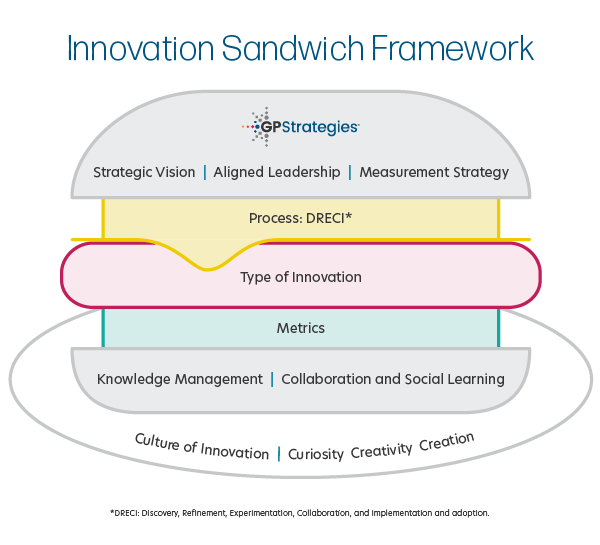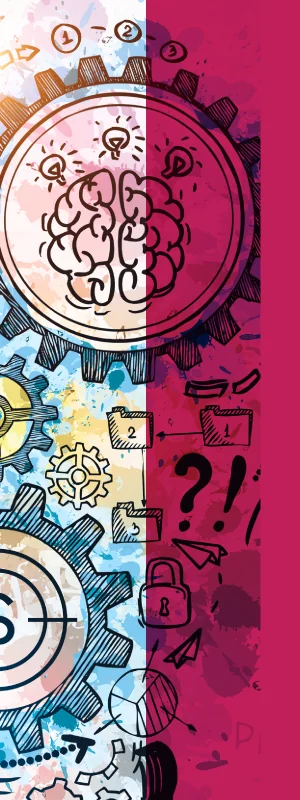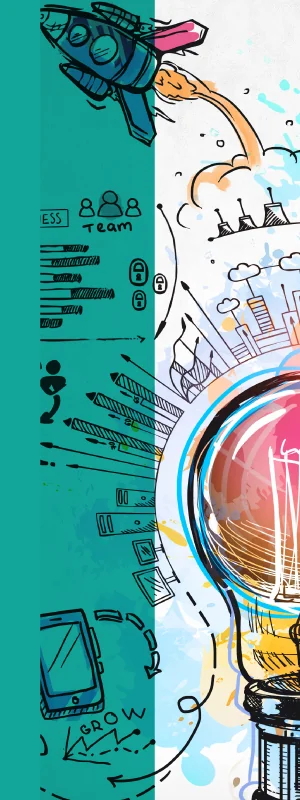Let’s face it: the term “innovation” is a siren of buzzwords. It paints a picture of historic successes and breakthroughs, skyrocketing profits, and massively productive employees. Beyond the feel-good jargon and gobbledygook, however, are powerful tools and mindsets that can actually proliferate real change and progress. Developing an innovation framework can help you and your organization to not just create new things and develop new ideas, but to see those ideas and creations make a real impact. The challenge lies in sifting through the unstructured, fluffy space that is innovation frameworks.
The Innovation Misconception
There is a widespread misconception that innovation is some otherworldly, extraordinary element that the lucky few stumbles upon. Realistically, you want your innovation potential to be sustainable and reliably accessed over time.
If you want innovation, you need tools to understand and gauge innovation. You need science, not magic.
Regardless of industry or mission, the goal of every organization is to thrive, especially during times of disruption. But if thriving bottom lines and employees don’t just manifest out of thin air and luck, how exactly do we reach our potential, aim higher, and create growth or progress?
Innovation vs. Invention
Innovation and invention are often mistakenly considered the same thing. Invention is a new insight or product; it usually has great value. However, innovation is a step further—it is something new that has value and is adopted.
Adoption is key here. Innovation as a capability is an organization’s widescale ability to initiate innovation, to create those valuable new things, and to see them through to adoption. If a new product, service, or system isn’t adopted by your people or received well in the market, it was more of an invention than an innovation.
Some businesses may experience innovation without aiming for it. Businesses that experience this happy accident—innovation without an innovation framework—may find it difficult to sustain the practice of creating useful, profitable, and marketable goods and services. You may have an explosively successful team of inventors, but if the process you use to create new things cannot be measured or reproduced, your innovative progress cannot be maintained. This is where innovation frameworks become a key player.
If the process you use to create new things cannot be measured or reproduced, your innovative progress cannot be maintained. This is where an innovation framework can become a key player.Matt Donovan

What Is an Innovation Framework?
An innovation framework is an organization’s strategic approach to continuously generate new ideas, test and evaluate those ideas, make evidence-based decisions about them, and ultimately operationalize or launch the innovation. Without an innovation framework, you may be missing out on ideas and talent potential across the organization. It is important to note that innovation frameworks are unique to the organization and its competitive needs. There’s no one-size-fits-all approach.
Despite all the variations in innovation frameworks, at their core, successful innovation frameworks include elements that allow for systemic, systematic, and sustainable innovation.
Your approach to innovation needs to be:
- integrated into your culture (systemic),
- measurable and predictable (systematic),
- something your organization can continue to do over time (sustainable).
If you want to create a culture that promotes the innovative behaviors of curiosity, creativity, and creation, you must create an environment that allows for and encourages those behaviors. An innovation framework can do just that.
Subscribe to our newsletter to receive insights, expertise, and big ideas delivered to your inbox!
Elements of an Innovation Framework
Innovation frameworks can be created and adapted to specific needs and even timeframes; there is no “right” way to develop an innovation framework for every situation or business. There are, however, several elements that successful innovation frameworks share.
The following visual encapsulates all of the moving factors that must coalesce to create the environment innovation needs to thrive, from cultural considerations and leadership alignment to the innovation process and knowledge management. Think of it as the Innovation “Sandwich” Framework.

Let’s unpack all of the elements in the “innovation sandwich.”
Culture of Innovation and the 3Cs
If the first row of elements and the final row of elements are pieces of bread holding together the meat, cheese, and toppings of our innovation sandwich, then creating a culture of innovation and of curiosity, creativity, and creation (the 3Cs) is the plate the sandwich sits on top of.
Cultivating innovation and the 3Cs is about creating the environment in which the behaviors needed for innovation can thrive. It’s more than tolerating questions about processes and procedures and ways of institutional thinking—it’s about embracing and encouraging these types of questions and turning them into productive components of your culture.
An environment where curiosity is reinforced, creativity is encouraged and developed, and creating and building new things is celebrated generates the kind of culture that innovates, measures outcomes, and goes back to the drawing board with information to create something new yet again. This kind of environment often involves embracing disruptions to patterns of work, which can be an obstacle for some organizations. But finding ways to nurture these elements can make enormous impacts on business outcomes over time.
If you want to create a culture that promotes the innovative behaviors of curiosity, creativity, and creation, you must create an environment that allows for and encourages those behaviors.Matt Donovan

Strategic Vision, Aligned Leadership, and Measurement Strategy
The top piece of “bread” in the innovation sandwich encompasses three vital aspects of an innovative workplace: strategic vision, aligned leadership, and a measurement strategy.
Strategic Vision
A strategic vision creates value by outlining aspirations for the future of innovation within an organization—but it goes beyond that. It is crucial to the communication process involved in generating adoption because it articulates the “why” behind your desire to innovate, who will be innovating, where the innovation should take place, and when it should be happening. It’s certainly possible to implement an innovation framework without a strategic vision, but if this step is skipped, your people won’t know what they’re aiming for, where the arrows are landing, or who should even be holding the bow.
Aligned Leadership
Closely related to developing a strategic vision for innovation is aligning your leadership. You must have leadership buy-in of your strategic vision for your organization at large to adapt to a shift toward innovation. If your leaders are not on board with the strategic vision, the strategic vision is no longer a unifying goal; it’s just a dream. It’s not enough for leaders to say they bought into the vision. They must reinforce it whenever possible and weave it into the fabric of your organization’s culture.
Measurement Strategy
The final part of this section of the innovation sandwich is a strategy for measurement—along with your strategic vision and aligned leadership, you must have a standard process in place for measuring success. The entire goal of developing an innovation framework is to set up a repeatable process for creating new things that get adopted (either in or outside of your organization). Being able to replicate a process over and over requires a standard for success.
Knowledge Management, Collaboration, and Social Learning
The bottom piece of “bread” in our innovation sandwich is about the flow of information. And just like how that bottom piece of bread for your sandwich needs to be strong to hold everything together, so does your knowledge management and social collaboration.
Knowledge Management
Mastering knowledge management is one of the most difficult parts of this process—you need an on-demand system for finding, retrieving, and sharing information logically. This may involve an advanced and appropriate tagging system for job aids and something like a robust SharePoint site for resources. Different approaches will work better for different organizations depending on their needs, but regardless of the chosen system, it needs to be so easy to use and access that your people find themselves using it frequently in their flow of work.
Collaboration and Social Learning
Connected deeply to your knowledge management system is the infrastructure you have in place for collaboration and social learning. How your talent collaborates and learns together is deeply engrained in your culture—which is why the 3Cs are so vital to have in place before developing an innovation framework.
If you can create an environment where people connect to solve problems and share insights about their experiences, you can almost stumble upon innovative thinking. If you can pull together two or three great insights into a problem and then turn those insights into a solution, you have innovation. The trick is in pooling all of that knowledge, those questions and challenges and insights, into one place for people to collaborate and learn from one another.

The Innovation Framework: The Type of Innovation, a Clear Process, and Metrics
Now that we have our plate (your culture of innovation) and both pieces of bread (your strategic vision, aligned leadership, measurement strategy, knowledge management, and social learning and collaboration systems) in place, we can finally start to assemble the star ingredients of our innovation sandwich: the type of innovation you need, your process for innovation, and your metrics.
Types of Innovation Frameworks
Innovation can occur in all areas of business, so it’s important to outline what you are innovating for as well as how you will innovate. Depending on your needs, you may have innovation frameworks for all elements of your organization, or just one.
Here are the most common types of innovation frameworks:
- Business Innovation: A business innovation framework allows organizations to identify and create new business models that generate value. The purpose of a business model innovation framework is to pinpoint areas of strength and opportunity, to better serve your clients, and to gain a competitive advantage through creating new revenue streams and entering new markets.
- Product Innovation: A product innovation framework is a structured approach that helps companies develop and bring new products to market successfully. It provides a systematic way to identify customer needs, design and develop new products to meet those needs, and launch the products into the market.
- Process Innovation: A process innovation framework is a method that helps organizations identify, create, design, and execute new and improved processes that boost efficiency, reduce costs, and improve productivity. A process innovation framework might be used to enhance financial processes, human resources procedures, information technology practices, etc.
- Experience Innovation: Experience innovation frameworks aim to create and deliver new, interesting customer experiences. They can be used to create new products and services or enhance existing offerings to that end. The most commonly used experience innovation framework is design thinking, which is based on empathy and understanding customer needs.
- Knowledge Management Innovation: Knowledge management innovation refers to the development and implementation of new approaches and technologies that enable organizations to effectively manage and share their knowledge assets. By adopting innovative approaches to knowledge management, organizations can leverage their intellectual capital, improve decision-making, improve the employee experience, and, of course, drive further innovations.
- Enabled Workforce Innovation: An enabled workforce innovation refers to empowering and enabling employees to work more efficiently and collaboratively. It involves leveraging technology and unique practices to create a workplace that supports employee needs and improves their overall work experience. This often results in improved employee satisfaction and retention, which greatly benefits business outcomes.

A Clear Process: The Sustainable Ingredient for Your Innovation Recipe
The who, when, and why you want to achieve innovation were covered with your strategic vision, and you have also now determined what type of innovation you’re aiming for and where it will occur. Now you must determine the how: the process with which innovation will occur.
This is the heart of your innovation framework, and it—more than all other elements—needs to be the most sustainable ingredient.
The way you innovate must be a repeatable, evidence-based process that can be used time and time again.
At GP Strategies, our work follows this process:
- Discovery
- Refinement
- Experimentation
- Collaboration (reflection and sharing)
- Implementation and adoption
Depending on the needs of your organization, your talent, and the type of innovation you’re after, this process may vary widely. Regardless of how you choose to innovate, be sure you can replicate it to experience the benefits of innovation time after time.
Metrics
Metrics play a critical role in innovation frameworks by enabling organizations to measure and evaluate the success of their innovation initiatives and, therefore, make data-informed decisions about whether or not an initiative should be pursued further. Innovation metrics can be divided into two categories: input metrics and output metrics. Input metrics measure the resources invested in innovation, such as funding, time, and talent. Output metrics measure the outcomes of innovation efforts, such as new products, services, or processes, revenue generated, and customer satisfaction.
Innovation frameworks require metrics to:
- Track progress: Metrics provide a way to track progress toward innovation goals, identify gaps, and adjust strategies accordingly.
- Evaluate success: Metrics enable organizations to evaluate the success of their innovation initiatives and determine whether they have achieved their desired outcomes.
- Identify areas for improvement: Metrics can help organizations identify areas where they need to improve their innovation processes or invest more resources.
- Foster a culture of innovation: By tracking and reporting on innovation metrics, organizations can foster a culture of innovation and encourage employees to contribute to the process of innovation.
The use of metrics is critical to ensuring that innovation efforts are productive and aligned with organizational goals. By measuring the inputs and outputs of innovation, organizations can make data-driven decisions and continuously improve their processes.
Innovation vs. Misinnovation: The Case for Flexibility
Innovation frameworks require us to not just invent something new with value but to develop a roadmap for identifying and encouraging adoption. Crucial to this process, too, is the ability to be flexible, and sometimes, the adoption of an innovation can deter our ability to make future adjustments.
The adoption phase can, if done haphazardly, be a limiting factor in innovation itself. If the adoption of something new is so significant that sets a production standard that resists future innovations, the growth of entire industries can be hindered.
This is something we call misinnovation.
Misinnovation occurs when something that was created cannot bend and shift to new demands or blinds us from additional future possibilities.
Beware of rushing your innovation to market or into another form of adoption if your creation cannot be easily altered or adjusted to new needs in the future. We will dive deeper into the topic of misinnovation—including examples and how to avoid it—in future publications.
Transform Your Organization by Developing Innovation as a Capability
You do not need to simply hope for innovative behaviors to come along and magically change your approach or change your industry. You can develop innovation as a capability by using a framework in which innovation can happen—this framework, in turn, can help to create the workplace culture needed for people to feel psychologically safe enough to take risks and try new things.
For more information about navigating the challenges of learning innovation or how to unleash your organization’s innovation potential, check out our blog and our award-winning podcast on the GP Strategies website.

About the Authors
Matt Donovan
Throughout his career, GP Strategies’ Chief Learning and Innovation Officer Matt Donovan has applied his decades of experience to support significant transformation initiatives for a wide range of Global Fortune 500 companies. A demonstrated thought leader, Donovan’s work is recognized across the industry. His articles are regularly published and presented at national and international conventions. He has a master’s degree in instructional systems technology from Indiana University.
Alisha Grace
Alisha Grace is a Marketing Content Writer and Editor, specializing in researching, interviewing, and weaving the ideas of GP Strategies’ subject matter experts and thought leaders into compelling articles, eBooks, and more. Alisha has a MA in Rhetoric and Composition from Winthrop University in South Carolina, and she was a critical thinking and writing instructor for her alma mater for several years post-grad. She also has extensive experience editing fiction for small publishers and self-publishing authors.

